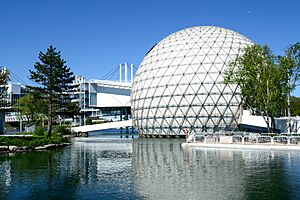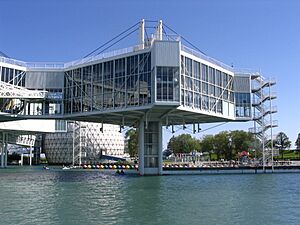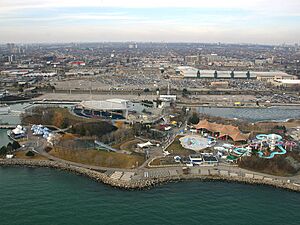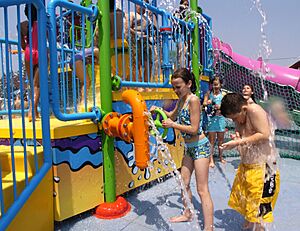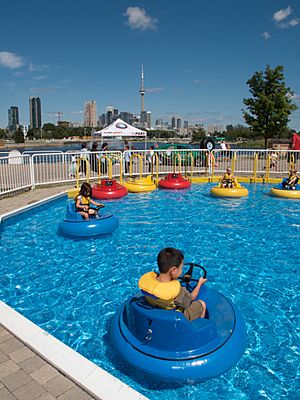Ontario Place facts for kids
Quick facts for kids Ontario Place |
|
|---|---|
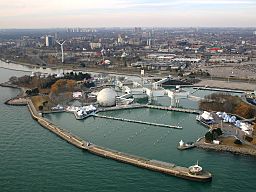
Aerial overview of Ontario Place, 2006
|
|
| Type | Park incorporating entertainment and event venues |
| Location | Toronto, Ontario, Canada |
| Area | 155 acres (62.73 ha) |
| Created | 1971 |
| Owned by | Government of Ontario |
| Operated by | Ontario Place Corporation |
Ontario Place is a cool park and entertainment spot in Toronto, Ontario, Canada. It's built on three man-made islands right off the shore of Lake Ontario. It first opened on May 22, 1971, as a fun theme park with rides and attractions about Ontario.
In 2012, the Government of Ontario decided to close the theme park part for a big makeover. Since then, Ontario Place has reopened as a park you can visit for free. Some of its famous attractions are still open, like the Budweiser Stage for concerts and the Cinesphere, which is an amazing IMAX movie theater. You can also explore Trillium Park and the William Davis Trail, which opened in 2017. There's even a marina where boats can dock, protected by three old ships sunk in the lake!
Contents
Discover Ontario Place's History
The Ontario Place theme park was open every summer from 1971 until 2011. It was first made to show off the Province of Ontario with cool exhibits and fun shows. Over time, it became more of a family theme park with a water park, a kids' play area, and rides.
The Forum was a popular concert stage at Ontario Place for many years. It offered free concerts by famous artists, which was awesome because it was included with your park ticket! The stage was round and even spun around during concerts, so everyone had a great view. In the 1990s, the Forum was replaced by a new concert venue called the Molson Canadian Amphitheatre.
After many years, fewer people were visiting the park. So, the Government of Ontario decided to close most of the park after the 2011 summer season. Only the music venue and the marina stayed open.
How Ontario Place Began
Before Ontario Place, there was a building at the Canadian National Exhibition (CNE) that showed exhibits about Ontario. After a very popular Ontario display at Expo 67 in Montreal, the government wanted to build something new and modern.
Ontario Premier John Robarts announced the plan in 1968. He said, "We want to use the natural beauty of the waterfront and modern designs to create a happy and open place, just like the popular Ontario Pavilion at Expo '67."
The park was first planned to be on land, but then they decided to build it on the water. They imagined five big, unique buildings called pods floating in the lake. These pods would be like mini-museums, showing different things about Ontario. They would hang from strong steel cables attached to huge poles in the lakebed.
Cool Design Ideas
Building Ontario Place was a big project! The architects faced a challenge: how to build the pods in the open water without spending too much money. One architect, Eb Zeidler, had a clever idea. He thought of creating "barrier islands" from city landfill. These islands would block the big waves from the lake, making it much cheaper to build the pod foundations.
The five main buildings, the pods, are square and made of steel and aluminum. They are supported by tall columns that rise high above the lake. Bridges connect the pods to each other and to the land. The whole park was designed to look modern and flexible, with bright colors and cool designs from the 1960s and 70s.
The Forum concert stage was on a central island, and a special children's village was on an eastern island. Everything was connected by carefully planned walkways and bridges. Each island even had its own color scheme! The children's village was designed by Eric McMillan and was a huge hit.
The Forum theatre could hold 3,000 people, with more seating on grassy hills. It had a unique roof and a stage that spun around, so everyone could see the show.
Designers also thought about the wind and waves. They built big hills covered with trees to protect the walkways from strong winds. To keep the harbor calm, they even sank three old Great Lakes ships to act as a breakwater!
A marina was also built for boats. It could hold up to 292 boats. This helped connect the park even more to the lake.
At Expo 70 in Japan, a new movie technology called IMAX was shown for the first time. It was so popular that they decided to build the first permanent IMAX theater at Ontario Place. This was the Cinesphere, a huge round building that could seat 800 people.
Ontario Place's design has won many awards. In 2014, the Ontario government even called it a "cultural heritage landscape of provincial significance," meaning it's a very important historical site.
Opening Day Fun
Ontario Place opened on May 22, 1971. The children's village wasn't quite ready for opening day, but it opened the next year in 1972. The park cost CA$29 million to build, which was a lot of money back then! On opening day, 23,000 people came to visit.
To celebrate, a special song called "Theme from Ontario Place" was created. The Cinesphere also showed a special film called North of Superior, which was about life in Northern Ontario. Over 1.1 million people watched this film in the first year!
In its first year, 2.5 million people visited Ontario Place. Even though it was popular, the park cost more to run than it made, so they raised admission prices the next year.
What Changed Over Time?
Ontario Place changed a lot over the years. The pod buildings, which once held exhibits, were later used for private events.
In 1980, a new exhibit called "Ontario North Now" was built on the west island. It showed off Northern Ontario with cool silo-like buildings and a small movie theater. Later, a boat ride and other attractions were added.
The original Forum concert stage was taken down in 1995 and replaced with the much larger Molson Amphitheatre. In 2011, another outdoor music venue called "Echo Beach" was added.
On the east island, the original children's play area, which had lots of climbing structures, was replaced by a big waterpark called "Soak City." This was the first water park in Ontario! Later, some small carnival rides were added too.
Park Closure and New Beginnings
In 2012, the government announced that the public parts of Ontario Place would close for a big redevelopment project. The goal was to make it a year-round attraction. Most of the park closed, but the marina, the Molson Canadian Amphitheatre, and the Atlantis event venue stayed open.
After some changes in government, new plans were announced in July 2014. Ontario Place would become an urban park, and the Molson Canadian Amphitheatre, Cinesphere, and the pods would be kept.
In 2017, parts of the East Island became Trillium Park, a beautiful new park with a trail called the William G. Davis Trail. The Cinesphere also reopened in November 2017 with new projection equipment, showing movies like Dunkirk and North of Superior.
In 2019, the government asked for "big, bold ideas" to redevelop Ontario Place. They said proposals couldn't include homes or casinos, and they had to keep Trillium Park and the Budweiser Stage. Organizations like the World Monuments Fund and the Architectural Conservancy Ontario are working to make sure Ontario Place's history and public spaces are protected for everyone to enjoy.
Fun Places to Visit Now
Today, Ontario Place is open every day without an admission fee. You can enter through the west entrance or the Trillium Park entrance. Some venues have separate tickets.
Budweiser Stage
The Budweiser Stage is a huge outdoor concert venue that can hold 15,000 people! It has a roof over the stage and inner seating. Many popular music concerts happen here during the summer. It used to be called the Molson Amphitheatre.
Cinesphere
The Cinesphere is an amazing IMAX and IMAX3D movie theater that can seat 600 people. It was one of the first IMAX theaters ever built! It shows a variety of IMAX films on weekends and is also used by the Toronto International Film Festival. The theater is inside a cool round building that looks like a giant dome.
Echo Beach
Echo Beach is another outdoor concert venue that can hold 5,000 people. It's designed to feel like the old Forum, but it has a real sandy beach section with awesome views of the Toronto skyline at night! Many great bands have played here.
Other Cool Spots
Ontario Place has two marinas with 240 slips for boats. You can rent a spot for your boat for the season or just for a visit. The marinas are open from May to October.
Trillium Park is a new park on the East Island. It has a walking trail, a firepit, a picnic area, and special plants.
The West Island has also been updated for fun activities and special events. In the winter, you can go ice skating, and in the summer, you can rent boats!
What Used to Be Here?
Children's Village
The Children's Village opened in July 1972 on the East Island. It was a huge playground with lots of active things to do! Kids could climb on big nets, slide down tube slides, jump on a giant air mattress, and explore a "foam swamp." It had 21 different activities! Over time, this area changed and was replaced by the water park and other rides.
The Forum
The Forum was a famous outdoor concert venue. It had a unique tent-like roof and extra seating on grassy hills. It was known for its rotating stage, which gave everyone a great view. Many famous artists played here, and concerts were usually free with park admission.
The Forum was taken down in 1994 to make way for the larger Molson Amphitheatre. Many people, including the original architect, were sad to see it go, but the new venue was built to bring in bigger shows and more visitors.
Froster Soak City
The waterpark started with Canada's first concrete waterslide in 1978. It grew over time with new water attractions like Hydrofuge and Rush River Raft Ride. Eventually, it became the "Soak City" waterpark in 2001. When it closed, it had five water slides, a pool, and a splash pad with interactive water jets!
Water Park Rides and Features
- Hydrofuge
- Lakeside Beach Spa Pool
- Pink Twister
- Purple Pipeline
- Rush River
- Topsy Turvy
- Tipping Bucket
- Splash Pad
Other Past Attractions
- HMCS Haida: This was a real Second World War warship that you could explore! It was saved from being scrapped by volunteers and became an attraction at Ontario Place. Later, it was moved to Hamilton, Ontario, to be part of a marine museum.
- Future Pod: This pod, opened in 1982, had cool displays about technology, communication, and energy. It even had a full-sized copy of the Canadarm, which is used on the Space Shuttle!
- The Canadian Baseball Hall of Fame and Museum: This museum was once located at Ontario Place before it moved to its permanent home in St. Marys, Ontario.
- Ontario North Now: This area on the west island showed off Northern Ontario with a wilderness adventure ride and a simulated mine.
List of Rides and Attractions (2011)
In its last season as a theme park, Ontario Place had many fun rides and attractions:
- Acrobatic Stage Show
- Cyclone
- Mini Bumper Boats
- First Flight
- Free Fall
- Tilt-A-Whirl
- Mini Greens (mini golf)
- Super Slide
- 4D Ontario
- Cyclone Speedway
- Aquajet Racers
- Waterplay Splash Pad
- Cinesphere in IMAX 3D
- Atlantis – Restaurant/Club
- OP Driving School
- Bumper Boats
- H2O Generation Station
- Marina with Lake Ontario access
- Boat School
- Eco-learning center
- Earth Ranger
- Mega Bounce
- Wacky Worm – Ontario Place's first roller-coaster
- Wilderness Adventure ride
- 3D F/X Adventure Theatre
- National Helicopters
- Megamaze
- The Go Zone
- Treehouse Live! Waterfall Stage
Images for kids


